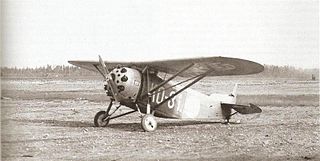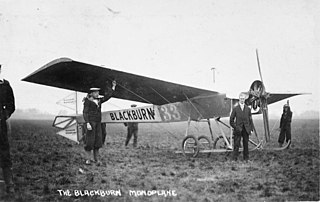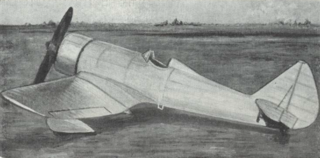
The Bloch MB.210 and MB.211 were the successors of the French Bloch MB.200 bomber developed by Société des Avions Marcel Bloch in the 1930s and differed primarily in being low wing monoplanes rather than high wing monoplanes.

The Tupolev I-4 was a Soviet sesquiplane single-seat fighter. It was conceived in 1927 by Pavel Sukhoi as his first aircraft design for the Tupolev design bureau, and was the first Soviet all-metal fighter.

The Tupolev I-12 was a prototype Soviet fighter aircraft that never reached production. The I-12 was of unconventional design with twin booms made of water pipes containing recoilless rifles and two engines in a push-pull configuration. The aircraft first flew in 1931 but did not enter production due to disappointing performance and operational difficulties such as the inability for the pilot to escape the aircraft without hitting the propeller arc behind him. The second prototype from Tupolev was never completed.

NVI F.K.31 was a Dutch designed parasol wing two seat reconnaissance-fighter, which was developed in the 1920s by Frederick Koolhoven. The aircraft saw some service in the Finnish Air Force.
The PZL.48 Lampart (leopard) was a Polish heavy fighter-bomber design, that remained only a project, owing to the outbreak of World War II.

The Morane-Saulnier M.S.225 was a French fighter aircraft of the 1930s. It was produced in limited quantities to be used as a transitional aircraft between the last of the biplanes and the first monoplane fighters.

The Blackburn Mercury was an early British aircraft designed as a pilot trainer for the Blackburn Flying School, Filey, in 1911. It was an enlarged, two-seat version of the Second Monoplane that flew earlier that year. It was a mid-wing monoplane of conventional configuration that accommodated pilot and student in tandem, open cockpits. This prototype was displayed at the Olympia Aero Show in March 1911, and led to orders being placed for two racers to participate in the Daily Mail Circuit of Britain race. The first of these crashed on takeoff, and the second was first rebuilt into a two-seat trainer, then into a single-seat trainer known as the Type B. Another six Mercuries were built for various private buyers.

The Bleriot-SPAD S.51 was a French fighter aircraft developed in 1924 in response to a French Air Force requirement for an aircraft to replace their obsolete Nieuport-Delage NiD.29s.

The Comte AC-4 Gentleman is a 1920s Swiss two-seat sport/training aircraft produced by Flugzeugbau A. Comte.

The Loire 46 was a French single-seater fighter aircraft of the 1930s. A high-winged monoplane designed and built by Loire Aviation, it was purchased by the French Air Force. It was also supplied to the Spanish Republican forces during the Spanish Civil War, but was almost out of service by the outbreak of World War II.

The PZL.4 was a Polish three-engine passenger aircraft for 10 passengers, built in PZL factory in 1932, which remained a prototype. It was the first Polish-designed and produced multi-engine plane.

The Bratu-220 was a Franco-Romanian prototype three-engined airliner of the 1930s, built in France.

The IAR 15 was a low-wing monoplane fighter designed in Romania in 1933. Designed by Elie Carafoli for the Romanian Air Force, the IAR 15 was a lightly armed low-wing cantilever monoplane with a radial engine, fixed undercarriage and open cockpit.

The Caproni CH.1 was a single-seat biplane fighter, a single example of which was produced as a prototype in Italy in 1935.
The Blanchard BB-1 was a 1920s French racing flying-boat designed and built by Société des Avions Blanchard to compete in Schneider Trophy.

The Bernard 70 was a 1920s design for a French single-seat monoplane fighter aircraft by the Société des Avions Bernard. It was not built but was developed into a racing monoplane designated the Bernard S-72,. It was further developed into single-seat fighters, the Bernard 74-01 and Bernard 74-02, although only two of the fighters were built.

The Bernard SIMB AB 12 was a French single engine, single-seat monoplane fighter aircraft built in the 1920s. Though advanced for its time, it failed to gain a production order and only one was built.

The Dewoitine D.9 was a French monoplane fighter built by Dewoitine and built under licence in Italy as the Ansaldo AC.3.
The Wibault 313, Wibault Wib 313 or Penhoët Wibault Wib 313 was a single engine, single seat low wing monoplane fighter aircraft, designed and built in France in the early 1930s. It was entered into a government competitive tender programme but was not ordered.
The Gourdou-Leseurre GL-820 HY family of four-seat single-engined floatplanes were designed and built in France during the latter half of the 1930s by Gourdou-Leseurre. The GL-820 HY and GL-821 HY 02 were shipborne reconnaissance / observation aircraft, while the sole GL-821 HY was built as a torpedo carrier.

















